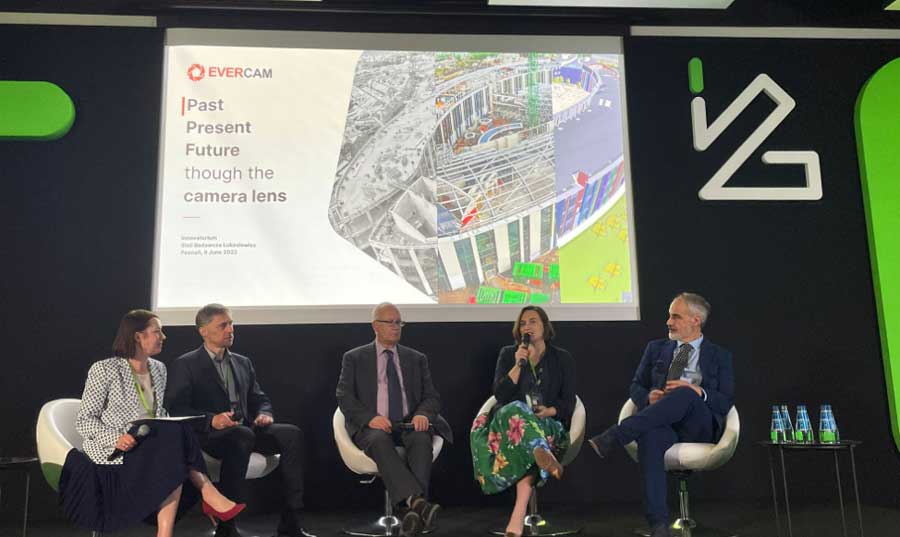
Evercam participated in a debate on innovation in Modular Construction during the Innovatorium conference organized by the Łukasiewicz Research Network in Poland
The Łukasiewicz Research Network is a unique project of great commercial potential. This network forms part of the scientific community that works to promote business and support the development of innovative SMEs in Poland. Operating in line with the Science is Business model, they network with business owners and offer solutions designed to help them enhance business operations and build game-changing technologies. The network also works within research groups made of specialists and experts from across institutes. The group’s objectives are to work out the project portfolio, exchange experiences and network.
At this year’s Innovatorium conference, Evercam was invited to participate in a panel discussion on Modular Construction. Panel members, including our very own R&D Manager Natalia Pińkowska, discussed their experiences in research and development in modular construction. They shared a variety of findings, including:
Dr Lidia Stępińska-Ustasiak, a Research & Operations Manager led the panel where they delved further into various reasons why modular construction is gaining popularity by the day.

Modular construction is increasingly becoming more popular due to its various benefits, including reduced waste, speedy building, cost-effectiveness, eco-friendliness, and flexibility. This type of construction involves creating the structure in sections off-site and importing it once it is ready to be installed. Little to no construction is completed on site which drastically reduces the space requirements and labor costs. As per industry experts, modular building projects can be completed 30% to 50% quicker than traditional construction.
Some of the reasons why there is an obvious growth in modular construction include;
Achieving Competitive Edge: There are hundreds of construction companies all vying for work in today’s market. Many contractors tender for one project at a go. This competitive market means that companies must seek alternative processes and look at ways in which they can gain a competitive edge. Modular construction is a fantastic way to reduce costs and provide a quicker, cheaper end product to the customer. A contractor offering custom modular structures could have a huge advantage over businesses using conventional methods.
Saves Space: The human population continues to increase, and this can cause overcrowding and a shortage of adequate housing and educational facilities. Governments require housing and schools to be built quickly and in often cramped spaces. Modular structures fill this requirement perfectly – they can be erected in a fraction of the time and take up less space than traditional building methods. Decisions can be made on whether to build on-site or just drag and drop structures from the factory; making unique applications much more accessible.
Cost-Effective and Viable Alternative: Modular construction is hugely cost-effective and much cheaper than traditional building methods. In recent years the world has seen a global state of recession. Companies and governments do not have the cash flow they once had at their disposal to invest in housing and other public infrastructure projects. Investing in prefab construction can be a cost-effective way to complete public infrastructure projects.
Health & Safety is prioritized: Modular construction offers a fantastic level of employee safety in comparison to traditional building methods. As most of the construction is carried out off-site, there are not the associated dangers and hazards that can be found on your traditional building site. Furthermore, factories where prefabricated construction is completed often work to stringent health & safety standards.
Less Landfill Waste & More Recyclable Materials
Modular constructed buildings are manufactured to high standards for a long and efficient working life. Right from the design stage, the aim of modular construction is to minimize the amount of material that goes to landfill. The more recyclable materials used, the less the environmental impact which goes a long way to achieving sustainability.
Less pollution: Construction using traditional methods is directly contributing to the global pollution problem pollution. Modular buildings minimize pollution in different ways. Building in a factory takes less time and produces less waste – and pollution – than conventional methods. It’s also far easier to track and control waste products for responsible disposal in a factory environment. In addition, the materials used in modular buildings tend to be lighter in weight than traditional construction materials, which reduces the emissions caused by delivery and transport.
Cleaner operations onsite
When a modular building is installed onsite, the process is quick, efficient, and remarkably clean. The whole modular construction process is rapidly achieved, requiring far fewer journeys to the site by the workforce, and far less risk of air, water, dust, and noise pollution.
At Evercam, there are a number of companies that have embraced this type of time-saving construction such as CPAC Modular and from our camera lenses, we can clearly see the past ways of standard construction, and the present adoptions in construction and the future innovations that can be adopted.